27 Circle of Learning
Teachings from the Four Directions
The concept “Circle of Learning” is adopted as a framework for organizing learning experiences designed to promote traditional Wolastoqey/Mi’kmaq knowledge, worldviews, traditions, ceremonies, histories, and teachings. It is a concept that embraces holistic learning whereby the four aspects of personal development (social, emotional, physical and spiritual) are addressed. The concept also instills within individuals the desire to be engaged in life-long learning. In addition, the Circle of Learning promotes the principles of respect, sharing, harmony, balance, equality and interdependence. Finally, learning experiences and the teaching of cultural topics are highly integrated which is consistent with the belief that all of creation is connected and therefore interdependent.
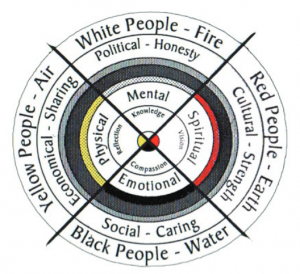
The primary purpose of the Circle of Learning framework is to help learners connect with all of creation. Learning experiences are designed to help students connect with the social, physical and spiritual realms. As they connect with the three realms, positive relationships are established and nurtured within the Circle. These relationships are based on the principles of respect and harmony. Learners embrace the principle of respect for all of Creation including their interactions with others in our social environments. This creates a web of harmonious relationships as the students continue their journey along the Circle of Learning paradigm.
The Circle of Learning establishes a safe and respectful learning environment that helps each student to develop a healthy self-concept and a positive self-esteem. This is accomplished by promoting ancestral languages, worldviews, traditions, and teachings. Traditional Wolastoqey and Mi’kmaq knowledge systems are recognized and promoted within the classrooms.
All learning experiences derive from ancestral worldviews, traditions, values and teachings. Within this framework, it is recognized that Wolastoqey and Mi’kmaq languages reflect the worldviews and value systems of each community. The ultimate aim is to establish a strong cultural foundation within each individual learner.
Learning experiences emanating from the Circle of Learning instills within individuals a sense of pride, self-worth, self-esteem, and belonging. Learners are culturally grounded and this leads to enhanced academic performance. Through Wolastoqey and Mi’kmaq cultures, students acquire academic skills in all subject areas. Wolastoqey and Mi’kmaq cultures provide the foundation for learning experiences designed to assist students acquire the skills targeted in all subject areas of the public school curriculum. Thus, it is important to incorporate Wolastoqey and Mi’kmaq perspectives, knowledge systems, worldviews, and traditions into the provincial curriculum at all levels of the education system. The Circle of Learning ensures that Wolastoqey and Mi’kmaq content are indeed incorporated into the public school system.
The Circle of Learning is a culturally-based educational framework. It is based on both Mi’kmaq and Wolastoqey knowledge systems, languages, cultures, worldviews, traditions and teachings. It is a framework that benefits all students of the public school system. It helps Wolastoqey and Mi’kmaq students to be culturally grounded while at the same time it helps non-Native students to be well informed about Wolastoqey and Mi’kmaq cultures, languages, histories, traditions, and conditions. It establishes a learning environment based on mutual respect, understanding, and appreciation among students. Our Elder scholars agree that the Circle of Learning will enhance the provincial education system.
Sacred Fire and Sacred Pipe
Long ago, Koluskap held a council with the Wabanakis. He asked everyone to sit in a circle so that he may share his teachings. Koluskap began the council by lighting a Sacred Fire and smoking his Sacred Pipe.
Koluskap began his teachings:
“Brothers and sisters, I always begin my Sacred Council Teachings by lighting a Sacred Fire and smoking a Sacred Pipe. Our Sacred Fire invites ancestors to the gathering so they can guide us in our journey of life. Like our Grandfather Sun, the Sacred Fire provides us with warmth, affection, kindness and generosity. The Sacred Fire warms our hearts so that we may feel compassion and love for others and for all of Creation. The Sacred Fire ignites truth, honesty, and wisdom within us and removes feelings of anger, resentment, and hatred from our councils and gatherings. Offerings are made to the Sacred Fire to give gratitude for each day of our Earth Walk.
Brothers and sisters, I smoke my Sacred Pipe to honor all of Creation. I smoke my Sacred Pipe to honor everyone within the circle and to remind everyone that we should always speak with truth and honesty. The Sacred Pipe will give us an open mind and a good heart. Your words will come from a compassionate and caring heart. The words that we use in council will be respectful and our discussions will lead to unity and harmony. The Sacred Pipe reminds us that we are one with all of Creation. Let us carry these teachings as long as the sun shines, the grass grow, the trees
stand, and rivers flow.My brothers and sisters of Wolastoqey and Mi’kmaq nations, thank you for listening. Remember these teachings and pass them on to your children and grandchildren. Instruct them to pass on these teachings to their children and grandchildren as well. These teachings will remain with you forever. I must leave for now but I will be back to share more teachings with you. We will have another council when I return from the Sacred Lodge. All My Relations!”
Once again, Koluskap ended the council by asking everyone in the circle to offer red willow tobacco to the Sacred Fire. He reminded the people that the offering was made to give thanks for Koluskap’s teachings. By now, all Wabanakis knew that the smoke from the Sacred Fire sends a message to our Creator that the teachings will always guide their actions.
Psiw Ntulnapemok
(All My Relations)
Dave Perley and Imelda Perley
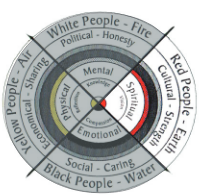 Eastern Teachings
Eastern Teachings
Eastern teachings come during the spring or child stage of life. The lesson of the child is to bridge the recent spiritual dimension with the new physical dimension. This is time to give thanks for all of Creation, for the four elements (water, air, fire and earth).
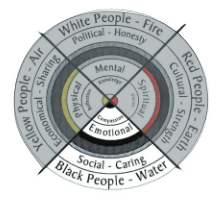 Southern Teachings
Southern Teachings
Southern teachings come during the summer or youth stage of life. The lesson of youth is to find balance and calm in the midst of change. Southern teachings also centre on the heart through kindness and compassion for others and all of Creation.
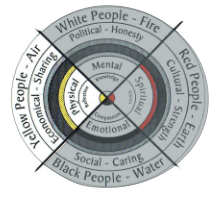 Western Teachings
Western Teachings
Western teachings come during the autumn or adult stage of life. The gifts of maturity and self-reflection are nurtured during this time. The gift of maturity allows one to strive for balance in mind, body, and spirit.
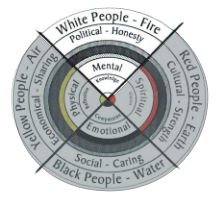 Northern Teachings
Northern Teachings
Northern teachings come during the winter or Elder stage of life. The knowledge gained through a lifetime of experience form a body of wisdom to be shared with those in earlier stages of life. We honor our Elders because of their wisdom and deep understanding of ceremonies and teachings from the four winds.
Attribution
Pages 29-32 in Wolastoqiyik and Mi’kmaq Studies: Elementary Level, Acculturation of the Curriculum Project. Psiw Ntulnapemok, (All My Relations), David Perley Project Leader. Natalie Sappier, Artist.
The Acculturation of Curriculum project acknowledges the valuable contributions made by our Wolastoqey and Mi’kmaq Elder scholars in the development of this study unit. Our respected Elder scholars provided the cultural knowledge required for Wolastoqiyik and Mi’kmaq Studies unit. We are indebted to Elder scholars Gwen Bear, Imelda Perley, George Paul and Gilbert Sewell who not only gave this project their full support but also gave their gifts of knowledge, wisdom, and expertise. We give thanks especially to the spirit of Gwen Bear who recently left the physical world and has entered the Sacred Lodge of our Creator. She will be greatly missed and her teachings will certainly remain with us.

